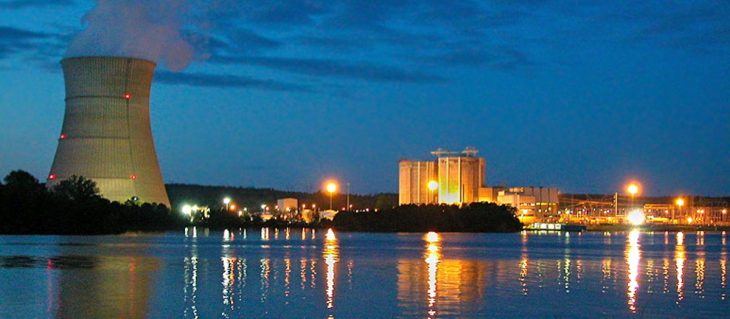U.S. nuclear power generation on the rise, industry trade group says
by January 22, 2016 9:40 am 247 views

Entergy's Arkansas Nuclear One power plant in Russellville, Ark. (photo from Entergy)
U.S. nuclear energy facilities generated electricity at a record high level of reliability in 2015 even as natural gas is expected to overtake coal as the top source for U.S. power generation this year, according to preliminary data from Washington, D.C.-based Nuclear Energy Institute and the U.S. Energy Information Administration (EIA).
Ninety-nine nuclear power plants operating in 30 states posted an estimated average capacity factor of 91.9%, based on preliminary 2015 data compiled by NEI. That surpasses the industry’s prior record set in 2007 by one-tenth of a percentage point. Capacity factor measures the total electricity generated as a percentage of potential generation for the entire year.
Dlectricity production from nuclear energy facilities last year was the fifth-highest ever, at an estimated 797.9 billion kilowatt-hours (kwh). The industry’s record high electricity generation came in 2010, when the 104 reactors then operating produced 806.9 billion kwh of electricity while posting an industry average capacity factor of 90.9%.
The amount of electricity generated in 2015 exceeded the amount produced in 2014, even though one less plant operated due to the 2014 closing of Vermont Yankee. This record efficiency is even more important as states strive to meet new carbon-reduction targets for the electric sector, NEI officials said.
“The 2015 data confirm yet again what a tremendous asset nuclear energy technology is,” said NEI Chief Nuclear Officer Anthony Pietrangelo. “U.S. nuclear power plants continue to operate at exceptional levels of safety and reliability, while generating affordable electricity that consumers and our economy rely on. This is due to the hard work and dedication of the highly skilled men and women who work at these facilities and the reactor vendors and suppliers who provide support services.”
During periods of extreme weather, the value of nuclear energy facilities is even greater, Pietrangelo said. For example, nuclear plants withstood historic flooding that overwhelmed several Midwest states from late December 2015 to mid-January of this year. Affected nuclear facilities included Fort Calhoun and Cooper Nuclear Station in Nebraska, Callaway in Missouri, Arkansas Nuclear One, Grand Gulf in Mississippi, and River Bend and Waterford in Louisiana. In all cases, the plants’ flood protection measures enabled reliable operation throughout the event, NEI said.
Nuclear energy facilities for the past two decades have annually produced about one-fifth of America’s electricity supplies, even as total electricity demand has increased significantly, according to the nuclear energy trade group. Because of their electric sector-leading capacity factors, they have done so even though nuclear power plants constitute only about 10% of the nation’s installed electric generating capacity.
NATURAL GAS TO PUSH PAST COAL
Meanwhile, the latest data from the U.S. Energy Information Administration (EIA) shows that U.S. coal production has continued to decline in 2015 since reaching a high point in 2008. Total coal production last year is expected to be about 900 million short tons (MMst), 10% lower than in 2014 and the lowest level since 1986.
At the same time, U.S. power companies may have burned more natural gas than coal to generate electric for the first time in 2015, according to a new report by Reuters. On a monthly basis, the EIA released data in July showing that natural gas overtook coal as the top power source in the U.S. for the first time ever this spring.
Preliminary data from the EIA showed that power plants used more gas than coal to produce electricity in five of the first 10 months of 2015, including the last four months that data was available – July, August, September and October. The next update to the EIA’s month electric generation data is Jan. 26.
